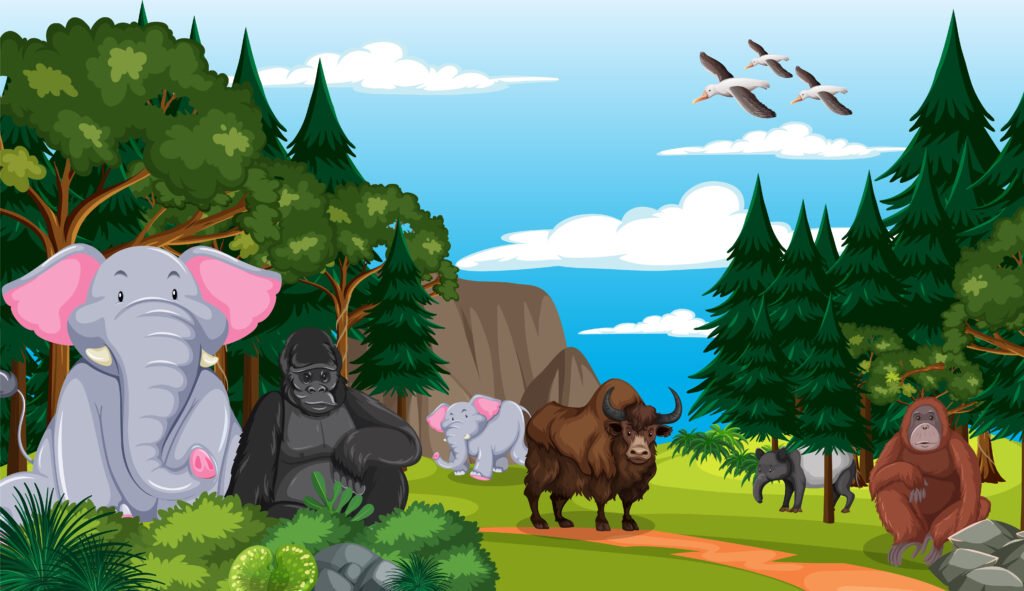What are the different types of animal habitats?
The animal kingdom is amazingly diverse, and its inhabitants have adapted to a wide range of habitats. Three primary categories of animal habitats encompass this outstanding variety.
Firstly, terrestrial habitats include land-based environments where creatures like mammals, reptiles, and insects thrive. This category spans from dense forests, home to species like bears and foxes, to open grasslands with inhabitants like lions and gazelles, and arid deserts where camels and meerkats have evolved to endure harsh conditions.
Secondly, aquatic habitats are water-based environments that house a lot of species. From the expansive oceans and seas, where dolphins and sharks roam, to the flowing rivers and streams, where otters and trout find their homes, and the smaller, enclosed ecosystems of lakes and ponds inhabited by swans and bearded dragons.
Lastly, aerial habitats involve the skies and airspace where birds, insects, and bats make their homes. Birds like eagles and hummingbirds construct complicated nests, insects create hives and colonies, and bats find shelter in caves.
Each of these habitat types presents its own set of living conditions and challenges, contributing to the vast biodiversity found on our planet. Animals have adapted to their specific habitats, showcasing the remarkable diversity of life on Earth.

What is terrestrial habitat?
Terrestrial habitats are land-based environments in which animals reside and adapt to the specific conditions of the Earth’s surface. These habitats encompass a wide range of ecosystems, including forests, grasslands, deserts, and more. Each terrestrial habitat presents distinct features such as climate, vegetation, and topography, which influence the types of animals that can thrive there. The diversity of life in terrestrial habitats includes creatures like bears in forests, zebras in grasslands, and camels in deserts, each having evolved unique adaptations to their surroundings. These habitats are essential components of Earth’s ecosystems, supporting a rich tapestry of biodiversity.
Forests
Forests are like huge, wild neighbourhoods for many different plants and animals. They are filled with tall trees and lots of greenery. In forests, you can find amazing creatures like jaguars, bears, and deer, living in their own special homes. It is like a magical world where nature’s beauty and wildlife come together.
Grasslands
Grasslands are wide, open areas covered mostly with grass instead of trees or forests. They are like large, natural lawns where animals like to eat and run around. Many different animals, such as lions, cheetahs, and gazelles, live there. These places are important for these animals to find food and survive.
Deserts
Deserts are dry and harsh places with very little water and plants. Some animals, like camels and meerkats, are specially adapted to survive in deserts. Camels have humps to store water, and meerkats work together to watch for danger. Even though deserts are hot and don’t have much food or water, these animals have clever ways to live there.
What is an aquatic habitat?
An aquatic habitat is an environment primarily defined by its water-based nature, encompassing diverse ecosystems such as oceans, seas, rivers, streams, lakes, and ponds. These habitats provide homes to a multitude of aquatic life, including fish, amphibians, and various aquatic invertebrates. Characterised by their aquatic conditions, these habitats present unique ecosystems and challenges, with adaptations ranging from the streamlined bodies of fish to the webbed feet of amphibians. Aquatic habitats are not only essential for countless species but also play a significant role in maintaining global biodiversity and ensuring the survival and interconnectedness of various ecosystems.
Oceans and Seas
The oceans and seas, comprising more than two-thirds of Earth’s surface, are expansive and diverse aquatic ecosystems. Sometime with life, they provide a home to an array of remarkable creatures. From the playful dolphins to the formidable great white shark, these vast, mysterious depths host a wide spectrum of marine life. This section offers insights into these animals, complete with captivating images and information about their marine homes.
Rivers and Streams
Rivers and streams create vital freshwater ecosystems, fostering a diverse array of aquatic life. Inhabitants such as the graceful swan, agile trout, and diligent beaver thrive alongside these flowing waterways. This section delves into the lives of these animals, offering images and insights into their unique riverine habitats, where the ever-changing current shapes their existence.
Lakes and Ponds
Lakes and ponds, as smaller freshwater bodies, present unique aquatic ecosystems. These serene environments house a variety of wildlife, from graceful swans to diligent bearded dragons and lively tadpoles. This section offers a glimpse into these animals’ lives and their distinct homes, highlighting the richness of aquatic biodiversity in these enclosed habitats.
What is an aerial habitat?
An aerial habitat refers to the environment above the Earth’s surface, where animals navigate the airspace. It includes birds, insects, and bats, which have adapted to life in the sky. Birds build nests in trees, cliffs, or man-made structures, while insects often construct hives, burrows, or nests. Bats, unique aerial mammals, primarily inhabit caves, tunnels, or roosts in trees. These habitats allow them to access food sources, evade predators, and find shelter for reproduction and rest in the open airspace.
Birds and Their Nests
Birds, as aerial experts, display remarkable diversity in nest-building strategies to protect and nurture their offspring. From the powerful eagle’s aerie to the delicate hummingbird’s tiny nest, each avian species showcases unique nesting methods and materials. This section provides insights and images into the fascinating world of avian architecture.
Insects and Their Homes
Insects, despite their small size, display incredible habitat diversity. They construct intricate beehives, forming complex, honey-making societies, while others establish subterranean ant colonies, showcasing their resourceful and industrious nature. This section offers a closer look at the remarkable world of insects and their distinct homes, providing images and valuable insights.
Bats and Caves
Bats, exceptional aerial mammals, are known to roost in the depths of dark and mysterious caves. This section delves into various bat species and their extraordinary cave habitats, shedding light on their intriguing adaptations and providing captivating images of these flying wonders in their subterranean abodes.
Unique Animal Habitats
Beyond the common terrestrial, aquatic, and aerial habitats, the animal kingdom boasts extraordinary specialised environments. These unique habitats often present extreme conditions, challenging species to adapt and survive. From the icy polar regions to the lush rainforests and intricate coral reefs, these extraordinary ecosystems showcase the wonders of nature.
Polar Regions
The polar regions, encompassing the Arctic and Antarctic, stand as some of Earth’s most unforgiving environments. Amidst the relentless cold and icy terrain, extraordinary animals such as polar bears, penguins, and walruses have evolved remarkable adaptations to flourish in these challenging settings. This section offers a glimpse into the lives of these resilient creatures, accompanied by images, shedding light on their exceptional polar habitats.
Rainforests
Rainforests, characterised by their dense foliage and abundant rainfall, are home to a plethora of unique and vibrant species. From the elusive jaguar to the colourful toucan, these ecosystems are rich in biodiversity. Explore the animals of the rainforest, featuring images and insights into their intricate homes, while discovering the vital role these habitats play in the Earth’s ecological balance.
Coral Reefs
Coral reefs are among the Earth’s most vibrant underwater ecosystems, renowned for their astonishing biodiversity. Teeming with life, they house an array of marine species, from the vibrant clownfish darting through the coral to the graceful sea turtle gliding amid the reefs. Explore the rich tapestry of animals that call coral reefs their home, complete with captivating images.
Beaver Dams
Beaver dams are remarkable constructions crafted by diligent beavers. Explore the fascinating process of how these industrious creatures build their watery abodes, altering landscapes in the process. Learn about the vital ecological role of beaver dams and their impact on local ecosystems, accompanied by images showcasing their engineering prowess.
Conclusions
In conclusion, the world is a dynamic stage where animals carve out their niches, adapting to various habitats in remarkable ways. From the deepest oceans to the highest skies, animals have found ingenious solutions to thrive in their unique homes. Understanding these habitats is not only a window into the natural world but also a reminder of the importance of preserving and protecting these diverse environments for the countless species that call them home.
Exploring the varied habitats of animals offers a window into the complexity and beauty of nature, reminding us of the interconnectedness of life on Earth. This journey through the homes of diverse species highlights the importance of understanding and preserving these environments for future generations. For more educational content that nurtures curiosity and learning, I encourage you to visit Chrysalis High.
FAQ’s
1. Why do some animals change their habitat?
Animals may change habitats to find food, escape predators, or seek better conditions for survival.
2. How do humans affect animals and their habitat?
Human activities like deforestation, pollution, and habitat destruction can harm animals and disrupt their habitats.
3. How many animal habitats are there?
There are various animal habitats, including terrestrial, aquatic, and aerial environments, each with unique characteristics.


